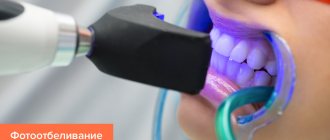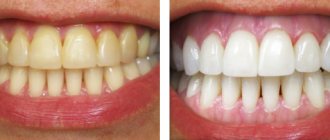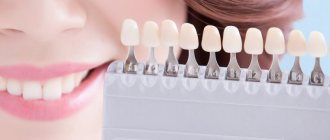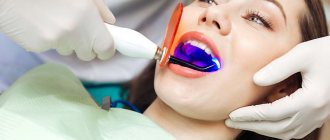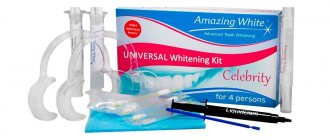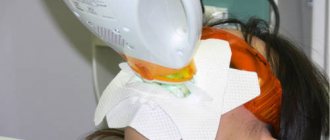Author of the article:
Soldatova Lyudmila Nikolaevna
Candidate of Medical Sciences, Professor of the Department of Clinical Dentistry of the St. Petersburg Medical and Social Institute, Chief Physician of the Alfa-Dent Dental Clinic, St. Petersburg
Drinking coffee and tea, smoking are the reasons for the formation of areas of enamel staining. The love of sweets, juices, fruits, combined with improper oral care, also leads to the fact that the enamel suffers: areas of demineralization, sensitivity, and caries appear. How to get rid of such unpleasant phenomena as dark pigment on teeth and sensitive enamel?
For this purpose, many different preparations are produced in the form of special toothpastes, gels, and varnishes. Let's talk about dental varnishes and alternative products. Some solve cosmetic problems and are intended for home use, others are used for therapeutic purposes and are applied by a doctor.
The essence of the method
The peculiarity of restorative whitening is that the method allows you to give your teeth not only the desired shade, but also correct minor flaws (chips, cracks, stains, gaps between teeth). Please note that restoration methods do not affect the original color of the patient’s enamel and do not contribute to the destruction of unsightly pigment, as classical methods do, namely, they hide the defect. In this case, the patient has the opportunity to choose the color and degree of whiteness of the enamel, that is, he receives a predictable result, which is usually difficult to achieve with traditional lightening methods.
It is impossible to whiten chips and cracks in enamel using the usual method.
The purpose of restorative whitening is to improve the appearance and even correct the shape of row elements located in the smile area. The procedure is not carried out in the chewing area, since the materials used for it are not designed to withstand heavy loads.
The essence of the procedure for restorative teeth whitening comes down to the fact that the doctor applies artificial material to the frontal (front) surface of hard tissues or glues thin but very durable overlays that exactly imitate the color and shine of natural enamel. If the patient wishes, the specialist will always be able to remove, refresh or adjust the restorations, or select a new color.
Example No. 3
A young aspiring singer needs a snow-white smile, but there is no time or money for a serious smile change. Composite teeth whitening helped her continue her career.
Indications for the procedure
- inability to achieve the desired effect using classical methods of enamel lightening: for example, if the patient has stains caused by severe forms of fluorosis and hypoplasia, yellow “tetracycline” teeth,
- sensitivity and increased abrasion of hard tissues: restorative bleaching performs not only an aesthetic, but also a protective function,
- in addition to the unsightly shade, the patient needs to eliminate a number of other defects: restore the anatomical shape of a chipped tooth, hide interdental gaps and cracks, hide old fillings, correct the position and shape of a crooked unit,
- age up to 18 years: some methods of restorative bleaching (for example, using composite materials) are suitable for young patients who are not yet allowed to use traditional methods of enamel lightening.
Indications for the use of the method are chips and defects of the teeth.
Restorative bleaching is not suitable for those who have severely damaged crown parts of the teeth and have periodontal diseases, leading to loosening and displacement of the roots. The procedures are also contraindicated in patients with serious occlusion pathologies. In these cases, doctors recommend other ways to solve the problem: prosthetics with crowns, treatment with braces and other orthodontic devices (alignments, trainers, arches, plates).
Example No. 1
Before her wedding, a young girl tried to whiten her teeth using conventional methods, but she was not happy with the result.
We selected the appropriate shade using computer modeling
and performed composite whitening in 3 hours.
A new snow-white smile will forever remain in your wedding photos.
Methods for carrying out the procedure in a dental office
Restorative teeth whitening can be performed in several ways. Let's list them.
Direct method, when the doctor corrects defects directly in the patient’s mouth
In this case, restorative bleaching is carried out in just one visit to the clinic. In the process, the specialist removes plaque and grinds down the enamel a little (to level the surface and better adhesion of fabrics to artificial materials), and then applies layer-by-layer layers of composite (there can be 10 or more of them), which are then polymerized with a special lamp. The doctor achieves the required shade, forms the desired shape, position and size of the crown, and then carefully grinds and polishes the material.
The photo shows artistic restoration of teeth using composites.
This method appeals to a large number of patients, as it does not require serious financial investments. Moreover, the result of such restorative bleaching can be corrected at any time. But the direct method also has certain disadvantages:
- it is necessary that such exquisite work be performed by a professional doctor, otherwise you may be disappointed in the result obtained,
- The composite material is stained by food and drinks, and plaque deposits on it. In addition, the composite does not have the shine of natural enamel, so over time it becomes dull and needs to be polished. To maintain the restoration in good condition, you need to visit the dentist at least once every 3-4 months.
“I really hoped to whiten my front teeth, because there are dark spots on them, but the doctor categorically forbade it. He said that the spots are caused by a disease, and bleaching not only will not help me, but will further deteriorate the condition of the enamel, making it thinner and more sensitive. I was very upset and was going to get crowns, but the specialist suggested a less radical and more affordable measure, namely restorative bleaching with a composite. Without thinking twice, she agreed. Yes, the method has disadvantages, but it’s better than walking around with spots like mine. I can say that it’s definitely worth doing the procedure if you have a similar hopeless situation.”
Karine, review from otzovik.com
Indirect method, when the restoration is pre-created in the laboratory
In this case, it will not be possible to get by with just one visit to the doctor.
At the first stage, the specialist prepares the teeth that need restorative bleaching and takes impressions of the jaws. During the preparation process, it is necessary to cut down the enamel layer (usually 0.3 to 0.8 mm of tissue is removed, which depends on the thickness of the onlay chosen by the patient). During the production of restorations, the doctor covers the prepared tissues with caps that protect them from destruction, bacteria, temperature and hardness of food.
At the initial stage, dental impressions should be taken
At the second stage, the resulting impressions are sent to the laboratory, where technicians create thin onlays from materials such as composite, ceramic, ceramic composite, and zirconium dioxide. The waiting process for restoration overlays usually takes about 2-3 weeks.
Direct restorative teeth whitening is usually carried out by a dentist-therapist, but indirect restorations are carried out by an orthopedic surgeon.
At the third stage, in fact, restorative bleaching takes place, but in this case it would be more correct to call it microprosthetics. The specialist processes, disinfects and thoroughly dries hard tissues, after which he places the thinnest snow-white overlays on their surface, which are securely and permanently fixed with dental cement.
Installing veneers will help change the color, shape and size of teeth
Among the advantages of this method: durability (7-15 years or more), high level of aesthetics, preservation of the original color of the restoration throughout its entire service life, resistance to dyes from food and drinks, protection of sensitive enamel from bacteria, caries and destructive processes. But there is one significant drawback - the high price.
How to use
Instructions for applying teeth whitening varnish
- The varnish should not be applied to the damp surface of the teeth, as it will not adhere to the enamel. Before applying the varnish, you need to clean and dry the surface with a napkin or cotton pad.
- Some manufacturers add a retractor to their whitening kit. If available, place it in the mouth.
- Shake the bottle before use.
- The varnish is applied in a thin layer to the surface of the tooth in the direction from the gums to the cutting edge.
- Wait the recommended time for the polish to dry without covering your mouth. If necessary, apply a second coat of varnish until the enamel is completely covered.
Teeth whitening varnish can be treated at least every day.
Algorithm for applying fluoride varnish
- The working field is isolated from the adjacent surfaces of the lips.
- The surface of the teeth is dried with a cotton swab.
- The doctor coats the teeth front and back with fluoride varnish using a special brush or applicator. The number of applications is determined by the dentist.
- The patient needs to sit with his mouth open for 5 minutes to fix the composition.
It is recommended to carry out fluoridation in the dentist's office 2 times a year.
Standard whitening and restoration methods: what's the difference?
Dentists carry out laser, chemical, lamp and cosmetic whitening, where hydrogen or carbamide peroxide in different concentrations is used as the main active ingredient that corrodes the color pigment. But there are patients for whom the service is not suitable due to contraindications, and for them an excellent alternative is restorative teeth whitening, which allows not only to hide unsightly shades and stains, but also to correct a number of other minor defects (chips, cracks, slight curvature and tilt of teeth , cracks).
The main differences between classic and restorative bleaching are presented in the table below.
| Classic methods | Restoration | |
| Mechanism of action | The enamel brightens by 5-12 tones (depending on the method) under the influence of a gel with peroxide applied to the teeth and activated in various ways (lamp light, chemical components, laser) | The teeth are covered with a thin layer of composite and other materials, which the doctor skillfully applies or glues to the surface of the enamel, resulting in a snow-white smile |
| Possibilities | Changing the shade of enamel, removing persistent stubborn pigment from food and after smoking. The ability to remove stains from mild forms of fluorosis and hypoplasia | Comprehensive concealment of all minor defects: stains, chips, cracks, curvature. Getting not only the desired color, but also correcting the shape and position of the tooth |
| Contraindications | Thin and sensitive enamel, multiple caries, wedge-shaped defect and erosion, severe forms of non-carious lesions | Suitable for patients for whom traditional enamel lightening methods are contraindicated |
| Preparation for the procedure | It is important to treat tooth decay and other dental diseases. It is necessary to clean the fabrics from soft and hard deposits in order to obtain an even lightening effect. Also, the enamel is pre-strengthened with fluoride or remineralizing compounds with calcium | Traditionally, diseased teeth are treated, plaque is removed, and tissue is fluoridated. Before applying materials or installing onlays, be sure to grind off a small layer of enamel so that the smile looks natural |
| Condition of teeth after the procedure | Immediately after the procedures, tissue sensitivity increases. There is a reaction to cold, hard and hot foods | A layer of restoration materials protects hard tissues from any external influence |
| Durability | 2-4 years, provided that the patient diligently maintains the result, follows a “white” diet, carefully carries out oral hygiene, and gives up smoking | A smile can maintain its beauty for 5-10 years or more. However, some artificial materials cannot be stained by food. |
| Price | From 8,000 to 30,000 rubles for both rows of front teeth. The most inexpensive method is chemical. Expensive – laser and lamp technologies (for example, ZOOM). |
|
Example No. 4
Patient K. dreamed of a snow-white smile all her life. Before her 50th birthday, she wanted to fulfill her dream, but the question arose - either have a party or get her teeth done. Composite teeth whitening made it possible to organize a big party and amaze guests with a dazzling smile.
Composite teeth whitening
– an excellent alternative to chemical bleaching. Allows you to quickly and inexpensively get the desired result. In terms of cost, composite whitening of the 8 upper teeth costs approximately the same as ZOOM whitening.
Aesthetic restoration specialists NIK Dental Guru
Photos of Ruzmetova, Elizarova and Khabiev
Nuances you need to know before the procedure
It is often written on the Internet that restorative whitening is a non-invasive procedure during which the original structure and condition of the tooth are not disturbed, and the composite or onlays are simply glued to the patient’s enamel on top. But this statement is nothing more than a publicity stunt.
Imagine what the restoration will look like if you simply glue an artificial material on top of your teeth, which also has some thickness? Let's list the consequences:
- the tooth made will protrude forward and stand out from the rest, it will increase in volume,
- without preparing hard tissues, it will not be possible to hide existing defects, stains, irregular shape and curvature of the crown,
- the area at the border of the material with the mucous membrane, if you do not make a smooth transition or ledge, will generally look unnatural, will become constantly injured and inflamed, since food debris and bacterial plaque will constantly clog into the resulting gap.
Before installing microprostheses, the specialist grinds the teeth.
Before carrying out restorative bleaching, the doctor carries out, albeit minor, grinding of hard tissues from the vestibular (anterior), cervical and lateral sides. This procedure is also necessary to level the relief and surface of the tooth and ensure a tight fit of the materials, as well as their high-quality and durable fixation. Only patients who choose original lumineers1 can avoid preparation - in this case, the doctor only slightly grinds the enamel and treats it with glue before installing the onlays.
Notice
: Undefined variable: post_id in
/home/c/ch75405/public_html/wp-content/themes/UltraSmile/single-item.php
on line
45 Notice
: Undefined variable: full in
/home/c/ch75405/public_html/wp-content /themes/UltraSmile/single-item.php
on line
46
Rate this article:
( 2 ratings, average: 5.00 out of 5)
whitening
- Fleisher G.M. Lumineers - a new alternative to teeth whitening // Review. Dentistry. – 2014.
Structural features
Any coated metal crown is a one-piece construction. Previously, they were produced according to a standard sample, and then the doctor had to “adjust” the system to the characteristics of the patient’s oral cavity. Of course, this was difficult to do. Today the situation is different - all prostheses are made exclusively from individual casts, so little or no time is spent on adjustments.
The main advantage of metal systems is the variety of choices. Taking into account his financial capabilities and personal wishes, a person can order the production of units with lining, with or without coating. If you need to make a dental bridge, then the artificial teeth are not soldered together, but the system is immediately made in the form of a single, aesthetic row. This completely eliminates the presence of interdental spaces in which food accumulates.
Comments
Is it possible to immediately do restoration after regular whitening if you are not satisfied with the result?
Svetlana (02.10.2020 at 22:54) Reply to comment
- To eliminate serious color pigmentation, spots, as well as to correct other defects, doctors often combine methods of classical and restorative bleaching. If this is indicated, the classic enamel lightening is first carried out, after which the teeth are given time to recover and strengthen, and after 2-4 weeks restorations are performed.
Editorial staff of the portal UltraSmile.ru (05.10.2020 at 09:14) Reply to comment
Write your comment Cancel reply
Why coat your teeth with fluoride?
So what does fluoridation do? This method can be used by both adults and children to strengthen enamel and improve its strength properties.
Fluoride is an important element that not only makes enamel stronger, but also prevents the rapid proliferation of bacteria. Among other things, the resistance of teeth to an acidic environment increases, which means their surface becomes less susceptible to various types of destructive substances.
The fluoridation procedure must be repeated annually - then the teeth will be reliably protected from caries and not subject to premature destruction; The gradual leaching of calcium will stop, making the enamel stronger.
Fluoridation of teeth during pregnancy
During the period of bearing a child, most of all nutrients and minerals from a woman’s body go to the formation of the skeleton and muscle tissue of the unborn baby. Due to calcium deficiency during pregnancy, tooth enamel is destroyed, so fluoridation during this period is very useful. However, before applying fluoride to your teeth, you should have your mouth examined and consult an experienced dentist.
It is important to remember that severe toxicosis is the main contraindication to the procedure, so it is best to plan a trip to the dentist for the 2-3 trimester, when the pregnant woman’s health improves. During breastfeeding, the fluoridation procedure will also not be superfluous.
Fluoridation of teeth at home
Currently, preparations for fluoridation of teeth can be purchased in pharmacies or specialized clinics. Fluoride varnish is an effective remedy for strengthening teeth at home, but it should be used carefully and only after consultation with your dentist.
In order for fluoridation to bring visible results, it is necessary to take care of the cleanliness of your teeth. Next, you need to strictly follow the instructions included with the drug. Fluoride varnish should be used in courses - 3-4 procedures.
The most common way to strengthen tooth enamel is to use toothpastes containing fluoride. However, it is worth remembering that you cannot use these products for a long time - you need to alternate them from time to time with other drugs that do not contain fluoride.
Price
The price of fluoridation of teeth varies within 1500 rubles. For the jaw. Our doctors will announce the final cost after completing a free consultation. Upon examination, the feasibility of fluoridation becomes clear. The doctor needs to be told about chronic diseases; for example, fluoridation is contraindicated for some patients with diabetes. Sign up for a consultation now on the website.
“Aesculapius” has permanent promotions:
- Crowns made of zirconium dioxide at a price of 9990 rubles.
- Discount on surgical and therapeutic treatment on weekdays from 12 to 16.
- Favorable implantation “day to day” (-10% of the price in the price list).
- Aligners for correcting bites - from 30 thousand rubles.

